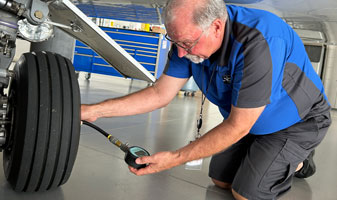Preventive maintenance is exactly that—doing something conveniently before something needs doing in an AOG situation.
Here is the FAA’s (Federal Aviation Administration’s) definition from 14CFR Part 1
Preventive maintenance means simple or minor preservation operations and the replacement of small standard parts not involving complex assembly operations.
Certain preventative maintenance items can be performed by a certificated private pilot. A complete list of those items is found in 14CFR Part 43 Appendix A (c).
The Preventative Maintenance provisions do not apply to any aircraft operated on an air carrier certificate. All work must be performed and returned to service by a certificated operator-approved facility or technician.
Duncan Aviation’s flight operations have a list of things we do regularly that could be considered Preventative Maintenance. Most of the items are service-related, but we prevent many AOG situations by doing them.
With a fleet of 14 aircraft as diverse as we operate, preventative maintenance takes on different roles depending on the aircraft type.
All of our aircraft get cleaned regularly to prevent paint deterioration and corrosion.
Since we are based in the Midwest, all our aircraft are hangared whenever they are at home base. In the winter months, we keep all of our hangars heated to prevent any cold-related issues that could come up.
On the small piston engine aircraft, we do a few simple things regularly, such as monitoring tire wear and pressure, inspecting the brakes for wear and leakage, and servicing fluids. We also inspect under the cowlings for anything that needs attention, like drive belts, the condition of the exhaust systems, and leaks.
Our maintenance technicians regularly check and service engine and APU oils, hydraulic fluids, and pneumatic pressures on our turbine-powered aircraft.

The most important preventative maintenance item we perform on all our aircraft is checking the tire pressure and servicing to specification.
This one item will save you time and money by optimizing tire wear and providing a safe aircraft.
Only in the jet world does the FAA have to issue an Airworthiness Directive to ensure that tire pressures are correct on specific jets before every flight.
December 2025
December 2025
December 2025
November 2025
November 2025